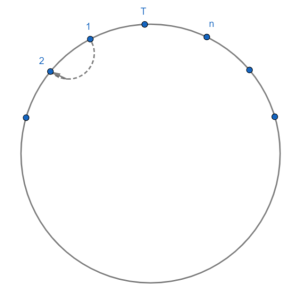In a previous post we considered a random walk problem on a graph. For a graph we start a walk from any vertex
Every time we get to a vertex
, we exit it along an edge incident with
with equal probability. Denote by
the event that the last new vertex is
that is, when we visit
all the other vertices of
are already visited and we visit
for the first time. We proved that in case
is a cycle with
vertices
for any two distinct vertices
In this blog post we discuss a reverse result of Laszlo Lovasz and Peter Winkler [1] that there are no other non-trivial graphs with the same property. Further, I closely follow the paper [2].
Theorem. (Lovasz-Winkler, 1993, [1]). Let be a simple connected graph with set vertices
Denote by
the event that a random walk starting at
ends at
as the last new covered vertex. Suppose
holds for any vertices . Then
is either a cycle or a complete graph.
Suppose the graph satisfies
. It means
for any
We should rule out all possibilities except
being a cycle or a complete graph. This filtering is based on two observations. The first one is a trivial, the other is also intuitive.
Observation. 1. The graph must be
-connected, i.e. removing any vertex of
leaves
still connected.
Indeed, suppose it’s false and removing a vertex makes
fall apart into two components, say
Take any vertices
Then
since it’s impossible to start from
visit all the other vertices of
and end up in
as the last visited new vertex – in order to visit
we should pass through
first.
Observation 2. Let be two vertices of
that are not adjacent. Then there exists a neighboring vertex
of
such that
Moreover, if after deleting and
the resulting graph is still connected, then this inequality can be made strict.
Sketch of a proof. Maybe, at first look it looks complicated, but it’s not. Let’s see what happens if we assume fails for all
adjacent to
that is,
holds for all
where
denotes the set of neighbors of
So, we start our random journey from
and there is
probability that we end up at
as the last new vertex.

But, after the first move, we are somewhere in and after that there is a greater probability that we land at
moreover, we are not obliged any more to hit
This is impossible. Hence, either there is
for which the inequality
is strict, or
for all Suppose now,
remains connected after removing
and
It means there is a path that starts from any
visits all the other vertices, except
and
and finally lands at
This path has a certain non-zero probability to happen, which means that being in
there is a greater probability to land at
than starting from
Of course this is not possible.
These observations are enough to narrow down the possible graphs that satisfy . Suppose
is a graph like that. It means
1) is
-connected (removing any vertex leaves the graph still connected).
2) Removing any two non-adjacent vertices of makes it disconnected.
Now, it boils down to prove that any graph that satisfies 1) and 2) is either a cycle or a complete graph. The proof of this claim is not present in [2] and I don’t know how it was done in the original paper [1] of Lovasz and Winkler, I haven’t seen it. Here is a possible approach.
Let’s take a spanning tree of
using depth- first-search algorithm starting from a root
This algorithm guarantees
has not cross edges, i.e. all the edges of
that are not edges in
connect comparable vertices in
If
has more than
leaf then those leaves are not connected (in
) and removing two of them results in still connected graph. Hence,
contains only one leaf, that is,
is a path starting from
and ending at
Note that
and
should be connected (in
) because otherwise we can remove them both and the graph would be connected. Thus, there exists a cycle
that passes through all the vertices of
If there are no other edges,
is a cycle. Suppose it has a chord that connects
and

Now, if there exists a pair of red and blue vertex that are not connected (see fig. 2), we can remove them and the graph would be still connected. Thus, any red point is connected to any blue one. Further, if there exist two vertices that are not connected we can remove them, again contradicting the condition 2). Hence,
is a complete graph. That is it.
References.
[1] L. Lovasz and P. Winkler (1993), A Note on the Last New Vertex visited by a Random Walk, Journal of Graph Theory 17, 593–596.
[2] Tim Dwyer, Uniform distribution of last new vertex in random walk on a graph determines (almost) the graph.
[3] AoPS thread.
[4] A Random Walk on a Graph. Part 1.

